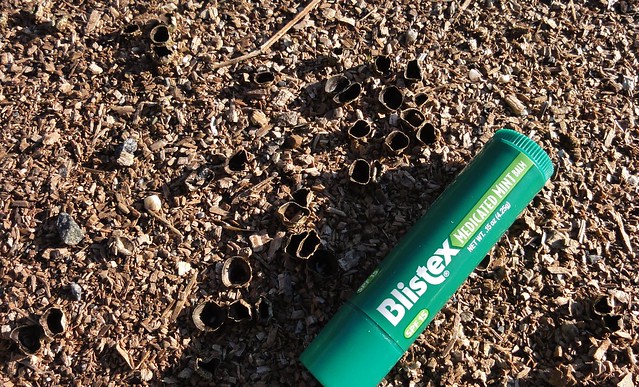Last winter, I saw a scattering of little black bits on one of the tree planter dealies. I thought at first someone had dropped a bit of something from a pocket, but upon bending over, determined it was a scattering of the most delightful wee black cup-shaped fungi I’d ever seen. I didn’t tend to carry the camera everywhere then, and the weather was lousy for a while, and just at the time I had both camera and good weather, some bugger had buried all my wee black cups under a quarter ton of compost.
Next winter, I vowed. I shall photograph them next winter.
And I did.
You can see how they’re overwhelmed by a simple tube of lip balm. They’re incredibly small.
If we kneel down and peer inside, we begin to see detail: the pale rings alternating with dark bands, the somewhat corrugated texture of their walls, the splits therein. Some of them are closed at the bottom, others open. Some are round, some are oblong. Some are wide-open, some are very narrow. Quite a variety for fungi that, at a glance, just look like a scattering of black freckles on the ground.
They’re pretty tough and hardy. This year, no one’s gotten round to composting for a while, and these survived well into the winter, even making it through a few freezes. I’m suspecting they may be related to or a delicate variety of wood mushroom.
I came across a review of a book I’ll have to track down again, with a gentleman talking about how he’s convinced rocks and minerals will be much different on planets with no life. And I believe he’s right, at least in part. Rocks like limestone, of course, are obvious – I mean, there are entire swathes of the stuff that couldn’t exist without plants and animals. Coal? Yeah, you’re not getting that without plants, so far as I know. I look at things like the fungi above, busily going about their mysterious lives, and I wonder if even scattered wood-lovers like this may not change the geological record in some small way. That’s one of the reasons I get excited about travel to other worlds – we get a chance to compare and contrast.
You can see the full set of wee black delights here. I can’t wait to find out what they are! I’m glad ya’ll like educating my ignorant ass, and yes, I do brag about you at every opportunity.







Maybe Urnula craterium?
They’re so cute! Fungus adorabilibus (pardon my Latin)! :)
I think they are nidulariaceae, or birds nest fungus, the size and habitat is right. But they have lost their “eggs” which are spore balls and are washed out in rain.
@Lithified Detritus – Probably not; U. craterium is found on the east coast, not in the Pacific Northwest.
I’m inclined to go with Plectania nannfeldtii, which is native to the area and tend to appear in cold, wet weather, such as melting snow. Dana didn’t mention what kind of trees were in the planters; P. nannfeldtii likes conifers.
I think the fungi are too tiny to be plectania? I really want them to be a species of bird’s nest mushrooms but there’s no “eggs”!
I think like Onamission5: bird’s nest of some kind. Maybe the eggs have dispersed.
(I’ve had thousands on hickory wood chips the last 2 years, not this species though. Very persistent.)
What species is the mulch from would be interesting.
Could the book you’re looking for be “The Story of Earth” by Robert M. Hazen? He discusses the co-evolution of life and geology on earth.
@6: Bark mulch around here is mostly Doug Fir or Hemlock.
You are correct about U. craterium– I didn’t take the time early this morning to read the entry carefully. Was going mostly on appearance…
P. nannfeldtii does seem more likely.
The trees in the planters are deciduous, if that helps at all…
This is exasperating to me because I grew up surrounded by those little buggers but never learned what they were called! Baby fairy cup mushroom things. There I named them.
I think that what is more relevant here is the mulch they are growing on. Most likely conifer, according to Trebuchet, and that seems to fit with P. nannfeldtii.
Works for me…
Around here, wood chip mulch often is decorated with slime molds, which are pretty cool, because they move.
And this is why fungi in general freak me out. You never know when that chitin will activate. :/
I think your naming method should be used for all kinds of other things and considered official. So, please name everything, now.
I also see slime molds are no longer considered to be fungi. So maybe I can learn to love them (the fungi!!) again. :) Slime molds, however… The Blob wasn’t a documentary, was it…?
No, but if memory serves, the idea behind The Blob was originally inspired by slime mould.
Bird’s Nest Fungi! Quite common in the nature park I work at in Beaverton, OR.